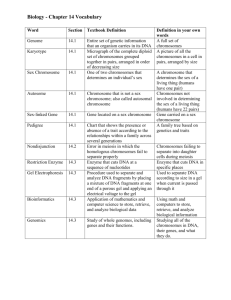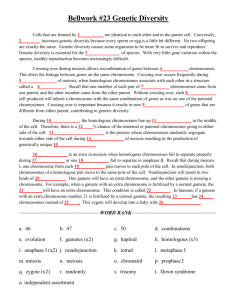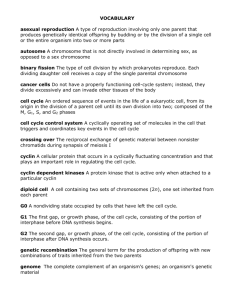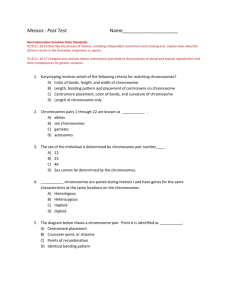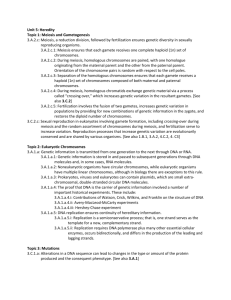SI Worksheet #6 (Review) BY123 Meeting: 7/1/15 @ 1pm in EB 132
advertisement
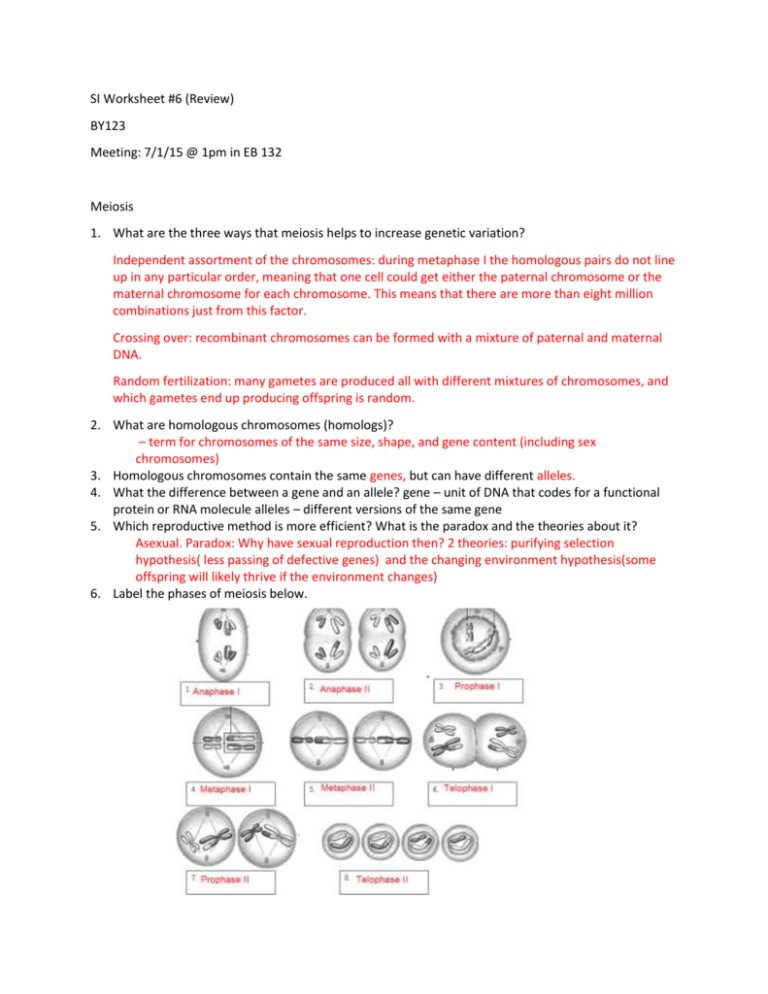
SI Worksheet #6 (Review) BY123 Meeting: 7/1/15 @ 1pm in EB 132 Meiosis 1. What are the three ways that meiosis helps to increase genetic variation? Independent assortment of the chromosomes: during metaphase I the homologous pairs do not line up in any particular order, meaning that one cell could get either the paternal chromosome or the maternal chromosome for each chromosome. This means that there are more than eight million combinations just from this factor. Crossing over: recombinant chromosomes can be formed with a mixture of paternal and maternal DNA. Random fertilization: many gametes are produced all with different mixtures of chromosomes, and which gametes end up producing offspring is random. 2. What are homologous chromosomes (homologs)? – term for chromosomes of the same size, shape, and gene content (including sex chromosomes) 3. Homologous chromosomes contain the same genes, but can have different alleles. 4. What the difference between a gene and an allele? gene – unit of DNA that codes for a functional protein or RNA molecule alleles – different versions of the same gene 5. Which reproductive method is more efficient? What is the paradox and the theories about it? Asexual. Paradox: Why have sexual reproduction then? 2 theories: purifying selection hypothesis( less passing of defective genes) and the changing environment hypothesis(some offspring will likely thrive if the environment changes) 6. Label the phases of meiosis below. Review Questions: 1. Which of the following processes or structures is mismatched with its location? A. light reactions—grana B. electron transport chain—thylakoid membrane C. Calvin cycle—stroma D. ATP synthase—double membrane surrounding chloroplast E. splitting of water—thylakoid space 2. Accessory pigments within chloroplasts are responsible for A. driving the splitting of water molecules. B. absorbing photons of different wavelengths of light and passing that energy to P680 or P700. C. providing electrons to the reaction-center chlorophyll after photoexcited electrons pass to NADP+ D. pumping H+ across the thylakoid membrane to create a photon-motive force. E. anchoring chloropyll a within the reaction center. 3. A cell in which of the following phases has the least amount of DNA? A. G0 B. G2 C. prophase D. metaphase E. anaphase 4. Which pathway is common to both fermentation and cellular respiration? A. the citric acid cycle B. The ETC C. Glycolysis D. Synthesis of Acetyl Co A from pyruvate E. Reduction of pyruvate to lactate 5. The final electron acceptor of the ETC that functions in aerobic oxidative phosphorylation is A. Water B. Oxygen C. NAD+ D. pyruvate E. ADP 6. In photosynthesis, photophosphorylation is most similar to A. substrate level phosphorylation in glycolysis B. oxidative phosphorylation in cellular respiration C. the Calvin cycle D. Carbon cycle E. Reduction to NADP+ 7. When electrons move closer to a more electronegative atom, what happens? A. The more electronegative atom is reduced, and energy is consumed. B. The more electronegative atom is reduced, and energy is released. C. The more electronegative atom is oxidized, and energy is released. D. The more electronegative atom is oxidized, and energy is consumed. 8. Plants can photosynthesis when _____________; they respire when _____________. A. light is available; light is available B. light is available; light is or is not available C. light is or is not available; light is or is not available D. light is or is not available; light is available 9. A molecule that is phosphorylated has A. an increased chemical potential energy; it is primed to do cellular work. B. been reduced as a result of a redox reaction involving the loss of an organic phosphate. C. a decreased chemical reactivity; it is less likely to provide energy for cellular work. D. been oxidized as a result of a redox reaction involving the gain of an inorganic phosphate. E. all of the above F. A and D 10. In a human karyotype, chromosomes are arranged in 23 pairs. If we choose one of these pairs, such as pair 14, which of the following do the two chromosomes of the pair have in common? A. B. C. D. They have nothing in common except they are x-shaped. Length and position of the centromere only. Length, centromere position, and staining pattern only. Length, centromeres positioning, staining pattern, and traits coded for by the genes 11. At the end of meiosis I, the resulting two cells are A. identical in all ways. B. genetically identical. C. genetically different. D. hexaploid. E. prepared to enter interphase so the chromosomes can be replicated. 12. If an organism's diploid chromosome number is 18, how many different possible combinations of homologous chromosomes lining up during meiosis exist for the eggs or sperm produced by that organism? A. 9 B. 18 C. 36 D. 128 E. 512 2n 18/2=9 29=512 13. Cytokinesis in plant cells differs from cytokinesis in animal cells because A. the contractile protein, actin, is important only in plant cells. B. a contractile ring forms only in plant cells. C. in plant cells, the cell plate must also divide into two parts. D. plant cells have a rigid cell wall. E. there is no difference. 14. Most cells are small. When they reach a certain size, cells typically divide. This has to do with the A. amount of genetic material. B. Surface-to-volume ratio. C. inability to produce more components of the cell membrane. D. fact that they cannot possess sufficient numbers of organelles for normal cell functioning. E. differences between viral particles and eukaryotic cells. 15. Microtubules are A. affected by cancer-fighting chemicals such as Taxol. B. responsible for formation of the contractile ring. C. involved in cell plate formation. D. only built up to make longer and longer microtubules. E. important during interphase of the cell cycle. Match the following phases with the proper description. A. a period in which the cell manufactures cellular molecules in preparation for replication of the genetic material B. a period in which the cell prepares for division by producing, among other things, much tubulin C. the actual division of the genetic material D. the actual splitting of the cytoplasm of the two daughter cells E. replication of DNA __E__ S __A__ G2 __D__ cytokinesis __B__ G2 __C__ mitosis A. separate, duplicated structures composed of DNA visible under the microscope B. genetic material that is "unwound" in between cell divisions C. a duplicated strand of DNA held to its duplicate by a centromere D. a proteinaceous band holding duplicate copies of the genetic material E. a structure that holds the sister chromatids to the spindle fibers _E___ kinetochore __A__ chromosome ___C_ chromatid __B__ chromatin ___D_ centromere A. mitosis B. meiosis C. both _A___ Produces genetically identical daughter cells __A__ Occurs in somatic cells ___B_ Gives rise to gametes __B__ Generally produces 4 daughter cells __C__ Requires chromosome replication must be completed beforehand




